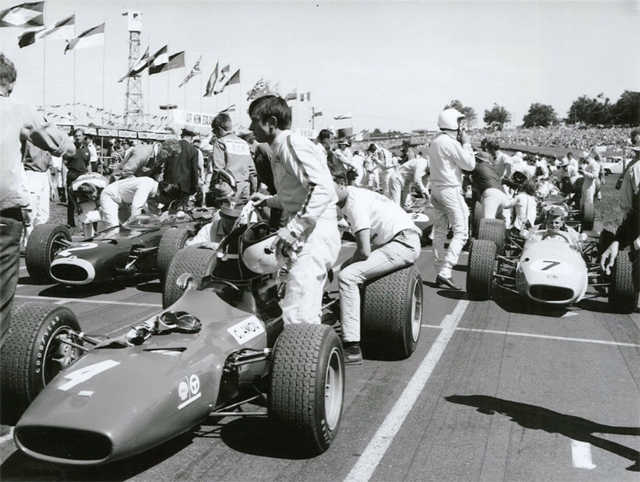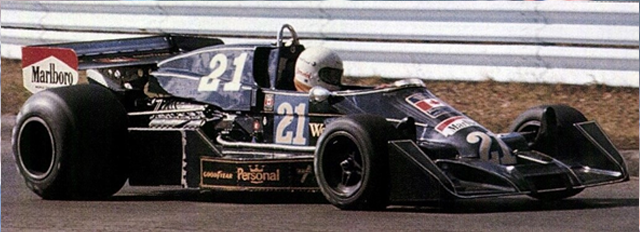
Australo-Kiwi based Tasman racing was begun back in 1964. And, since it allowed Formula 1 machinery with only light modification, the Grand Prix set, bored with the northern hemispherical winters, took the opportunity to go racing there throughout January and February, before their own school terms started in earnest.
27-Sep-22 historicracing.com
And so it was that famous names like Clark, Hill, Stewart, Brabham, Amon, Hulme and McLaren would compete to put ticket buying bums on seats for the Antipodean organisers.
By the early seventies, for economic reasons, Formula 5000 had replaced Formula 1. Which the Europeans found less attractive. But at least now, local constructors like Elfin, Matich, Bowin and Mildren from Australia, and Begg from New Zealand. Could take on the British and occasionally American, customer-car builders, with surprisingly good effect.
English made Lolas though, were easily the most plentiful type around. And so many drivers had crashed one, that the “Lola-Limp” was a widely worn trademark of the typical Tasmanian tiger!
But the racing remained highly competitive. and the 1975 edition, especially so.
When it came to the season’s finale, at Melbourne’s Sandown Park. There’d been five winners from the seven races held so far (there were eight races in total. First four in New Zealand, then four in Australia). With two wins each for Lola equipped Graeme Lawrence (from New Zealand) and Warwick Brown (Australia). And one each for the ex-Formula 1 Kiwis Chris Amon (driving an American built Talon) and Graham McRae (in his own McRae chassis. Built though, in the UK. Rather than his home nation) and Aussie, John, or “Johnnie”, Walker. Again, Lola mounted. But with the locally brewed, Holden based, Repco V8. In place of the wildly popular Chevrolet option.
Graeme Lawrence and Warwick Brown’s double victories, put them top of the table on thirty points each. But matching them, unexpectedly, was the Surfer’s Paradise race winner, Johnnie Walker. With a steady run of consistent point scoring.
Graeme had won the Tasman series back in 1970. And another title, at this mid-point in his successfully varied career, would be very welcome indeed.

While Warwick (a genuine Lola-Limper!) was still on the way up. And saw this Tasman Championship as his ticket to international stardom!

Johnnie though, probably hadn’t expected to still be the hunt at this stage. And for him, to be an actual Tasman Champion would be ambition fulfilment at its most satisfying!

When raceday dawned. It did so with Johnnie Walker, in his orange Lola-Repco, sitting comfortably in pole-position.
But when the flag was flapped, he fluffed his start and was immediately swamped by Warwick Brown and the Matich-Repco of John Goss. And was fighting hard to get back on terms, as they swooped onto the fastest section of the track, when his Lola suddenly jinked left (no-one knows why, not even Johnnie!) and skated off across the grass at an unseemly high velocity.
Now Sandown Park isn’t just a motor racing circuit. Or even, principally a motor racing circuit. Its daily preoccupation is with horse racing. And the infield boundary of the motor racing track, is marked by the characteristic white rail of the horse racing course. To which Johnnie was now strangely drawn.
Felling fence posts for some fifty metres or more. While shedding orange fibreglass galore and extensive, expensive, British made componentry. As the top rail, which held the water conduit for the sprinkler system, writhed about his hard-hatted, noggin!

Image courtesy: Robert Davies
Only when he’d finally shuffled to a standstill, was Johnnie found unconscious by the conscientious track marshals. And whisked off to hospital.
Back at Sandown Park though, his two main rivals were synchronously enjoying diverse experiences.
Graeme’s day was ruined by a mean-spirited fuel pump. That stopped him too, from reaching the finish.
While Warwick, with combustion-fluid issues of his own, had made a late stop to top-up and finish sixth. Which was just enough to make him guest-of-honour at the 1975 Tasman Championship winners party!
Johnnie, meanwhile, had come round to find himself largely unhurt. And shot straight back to the track, to collect his mangled machinery!
And as all this was going on, John Goss became the championship’s sixth different winner. In his Sydney sired, pure-Aussie, Matich-Repco A53.
.png)
Image courtesy: Robert Davies
His newly minted Championship medal though, did help Warwick Brown to map out something of the desired international racing career. Mainly in the USA. Where he enjoyed some years of F5000 and Can-Am racing. With a lucrative second place in the 1978 Can-Am series, as probably the highlight.
And briefly, very briefly, he even made it into Formula 1.
With his preferred pilot Chris Amon, out with a busted ankle. Frank Williams had been scratching around for someone to drive, at very short notice, in the 1976 United States Grand Prix at Watkins Glen. And Chris suggested Warwick.
The Williams FW05 though, was an appalling crock of ***insert any known poo simile here*** ! And probably the worst device ever to carry the illustrious, Williams name (although the current FW42 is giving it a run for its money!).
Warwick’s F1 debut then, was always going to be tough. But he’d made things worse for himself, late on the Thursday night. By throwing his hire-car down a wooded ravine, with a young Patrick Head onboard, on their way back to the country resort where Frank had them booked in for the weekend.
So, although he’d out-qualified his very experienced team mate, little Art Merzario. And brought the car home, albeit in last place, which is also more than Arturo managed to do. He wasn’t asked back.

Image courtesy: Unattributed
Graeme Lawrence continued to race at the top level, throughout Australia, New Zealand and the peninsular and Orient. But retired in 1983, with no more major titles to his name.
Johnnie Walker also retired in the early eighties. But although the 1975 Tasman series would prove the last of its kind (Australia and New Zealand having diverged their racing policies from that point), he would still enjoy boons. By zooming his replacement Lola (now with Chevrolet shove) around Wanneroo Park, near Perth.
To reap the 1979 Australian Grand Prix (which despite not joining the World Championship carnival until 1985, has a fine and venerable archive going back as far as 1928!) and liberate for his own amusement, Australia’s prevailing, premier title: The Australian Drivers Championship.
.png)
Image courtesy: Keith-Midgley
Good on yer, Johnnie!